A
Truly
Stylish
Asia
SRABONTI NARMEEN ALI
(Back from Kuala Lumpur)
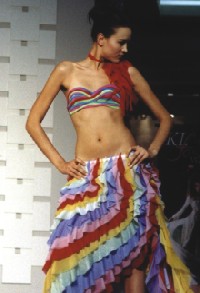 With
a global image of being an icon of the progressive east and
at the same time, as being one of Asia's most "hip and
trendy" metropolises, Kuala Lumpur is definitely the epitome
of a perfect blend between eastern and western traditions. While
staying true to their culture, the citizens of KL are also taking
globalisation into stride, which was evident during the nine-day-long
"KL Fashion Week," held from April 24 to May 2, consisting
of a number of different events, ranging from all day workshops
on beauty, to glamorous fashion shows. Organised by The Star
Newspaper in Malaysia and presented by L'Oreal, this is KL Fashion
Week's second consecutive year.
With
a global image of being an icon of the progressive east and
at the same time, as being one of Asia's most "hip and
trendy" metropolises, Kuala Lumpur is definitely the epitome
of a perfect blend between eastern and western traditions. While
staying true to their culture, the citizens of KL are also taking
globalisation into stride, which was evident during the nine-day-long
"KL Fashion Week," held from April 24 to May 2, consisting
of a number of different events, ranging from all day workshops
on beauty, to glamorous fashion shows. Organised by The Star
Newspaper in Malaysia and presented by L'Oreal, this is KL Fashion
Week's second consecutive year.
Linda Ngiam, Deputy Group, General
Manager of Star Publications, says "Fashion week is still
something very new -- we can now collectively be at pace with
the international fashion world. People are now paying attention
to Asia and we are increasingly getting recognition. Fashion
in Malaysia is growing. The tourism industry has built a platform
for designers. The Prime Minister's wife [Datun Paduka Seri
Endon Mahmood] is a supporter of arts and culture and also is
promoting Batik. We hope to be like other countries, in the
sense that we will incite buyers to come from other countries."
 With
a guest list comprising of the glitterati of Malaysia including
Ms. Malaysia--2003, Elaine Daly and actor Shamser Sidhu, KL
Fashion Week offered its participants global fashion exposure
in a number of ways. In contrast to last year, which featured
mostly local designers and models, this year's Fashion Week
was more inclusive of international designers and models. Participating
countries were India, Pakistan, Indonesia, Singapore, China,
Hong Kong and the Philippines, with the intention of taking
Malaysia's fashion industry a step closer to the global market.
With
a guest list comprising of the glitterati of Malaysia including
Ms. Malaysia--2003, Elaine Daly and actor Shamser Sidhu, KL
Fashion Week offered its participants global fashion exposure
in a number of ways. In contrast to last year, which featured
mostly local designers and models, this year's Fashion Week
was more inclusive of international designers and models. Participating
countries were India, Pakistan, Indonesia, Singapore, China,
Hong Kong and the Philippines, with the intention of taking
Malaysia's fashion industry a step closer to the global market.
With this in mind, Star Publications
organised all-day workshops on fashion and beauty, which gave
tips on how to wear the right clothes, how to take care of your
skin, and how to look your best. In a workshop conducted by
Frederique Buffin, a lecturer at the Jakarta, Indonesia chapter
of international fashion school ESMOD, participants got a sneak
peak of upcoming trends in the Spring and Summer of 2005, providing
an overview of current trends and the future direction of styles.
 The word on the
street is that the 80's look is out and the 70's resort (long
pant legs and sarongs) and 50's tourist (big skirts, jackets
without buttons, capris) looks are in. Think bold: the flag
motif (which gives a sporty flavour to the outfit), stripes
and graphics (for a more urban feel), flowers (for the feminine,
girly look) and madras prints (for the exotic look). Fabrics
range from chiffons (for an ethereal touch) and shiny glamorous
silks, to a more toned down and earthy rough look, which is
termed "plastic bandage" because of the way it feels.
To add that extra touch to your outfit, try ruffles, feathers
or glitter, but let go of the lace, because it's no longer in.
Experiment with contrasting and using bright colours. At the
end of the day, your image portrays who you are, so stay true
to yourself, above all else, which seemed to be every designer's
final say on fashion.
The word on the
street is that the 80's look is out and the 70's resort (long
pant legs and sarongs) and 50's tourist (big skirts, jackets
without buttons, capris) looks are in. Think bold: the flag
motif (which gives a sporty flavour to the outfit), stripes
and graphics (for a more urban feel), flowers (for the feminine,
girly look) and madras prints (for the exotic look). Fabrics
range from chiffons (for an ethereal touch) and shiny glamorous
silks, to a more toned down and earthy rough look, which is
termed "plastic bandage" because of the way it feels.
To add that extra touch to your outfit, try ruffles, feathers
or glitter, but let go of the lace, because it's no longer in.
Experiment with contrasting and using bright colours. At the
end of the day, your image portrays who you are, so stay true
to yourself, above all else, which seemed to be every designer's
final say on fashion.
In defining style philosophies
and theories during a workshop titled "From Plain Janes
to Vamps/From Plain Joes to Stylish Dudes", Mervyn Ho,
Division Manager for Hugo Boss in Malaysia, says, "Fashion
is not necessarily style but style is definitely fashion."
He adds that fashion is the ability to "express one's individuality
and personality through your clothes." The workshop ended
with the make-overs of two volunteers and in conjunction with
the above philosophy, the stylist executed subtle changes in
their appearances, instead of just following trends without
considering the person's original sense of style.
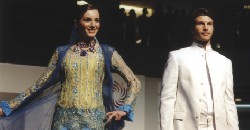 "Fashion
is an attitude," says Malaysian designer Sayfol, whose
collection this year focused on designs from the 1920's, emphasis
on black with splashes of colour. "No fashion designer
can change you or make you into something you are not, because
fashion comes from within, from inside. You cannot wear something
that is not you, because fashion expresses who and what you
are."
"Fashion
is an attitude," says Malaysian designer Sayfol, whose
collection this year focused on designs from the 1920's, emphasis
on black with splashes of colour. "No fashion designer
can change you or make you into something you are not, because
fashion comes from within, from inside. You cannot wear something
that is not you, because fashion expresses who and what you
are."
'Who and what you are' does
not always depend on individuality -- surroundings and culture,
which many designers at this year's fashion week exhibited,
are also influential. Playing on the "east is exotic"
mentality, models at the fashion shows strutted down the catwalk
in a variety of outfits, ranging from mini skirts in local prints
to sarongs and conservative, but glamorous styles for Muslim
women, using the hijaab or as it is termed in Bahasa
Malaysia, the ‘tudung'.
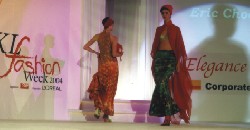 Four
local designers this year worked within the Muslim modes of
dressing. Their motto is "given the right fabric, colour
and design, Muslim fashion can be trendy." Designers from
boutiques Melor's Apparel, Boutique Ratu and Sri Munawwarah
showcased their take on Contemporary Fashion for Muslim Women
on the last day of Fashion Week in the KLCC Concourse Centre.
The sight of hijaabi models clad in outfits similar
to chic salwar kameezes -- be they glitzy bridal wear
in chiffon with sequins, or casual, comfortable, but snug attire
in local cotton fabrics and textile prints -- was a refreshing,
yet dramatic change from the daring outfits they had worn in
previous fashion shows.
Four
local designers this year worked within the Muslim modes of
dressing. Their motto is "given the right fabric, colour
and design, Muslim fashion can be trendy." Designers from
boutiques Melor's Apparel, Boutique Ratu and Sri Munawwarah
showcased their take on Contemporary Fashion for Muslim Women
on the last day of Fashion Week in the KLCC Concourse Centre.
The sight of hijaabi models clad in outfits similar
to chic salwar kameezes -- be they glitzy bridal wear
in chiffon with sequins, or casual, comfortable, but snug attire
in local cotton fabrics and textile prints -- was a refreshing,
yet dramatic change from the daring outfits they had worn in
previous fashion shows.
Designer
Michael Ong, whose collection this year also concentrated on
styles for Muslim women, is "inspired by the local scene
of Muslim girls wearing the tudung." His show began with
a dance sequence by twenty little girls in one-colour sequined
sarongs and long white shirts carrying baskets full of flower
petals, to throw on the runway.
 "Islam
is part of our Malaysian culture, so it's important to incorporate
that into the fashion industry here," says designer Amanda
Loke, who has been in the fashion industry for over ten years.
Malaysian by birth but based in Hong Kong and London, Loke has
offices in Greece, Malaysia as well as boutiques of her line
Aman Darling in St. Tropez, France. She specialises in luxury
resort-wear and beach-wear. She believes that "simplicity
is the key. My designs are practical, as well as feminine, stylish
and cool." Since her clientele ranges from young women
in their twenties to middle-aged women in their forties and
fifties, she designs "for everyone."
"Islam
is part of our Malaysian culture, so it's important to incorporate
that into the fashion industry here," says designer Amanda
Loke, who has been in the fashion industry for over ten years.
Malaysian by birth but based in Hong Kong and London, Loke has
offices in Greece, Malaysia as well as boutiques of her line
Aman Darling in St. Tropez, France. She specialises in luxury
resort-wear and beach-wear. She believes that "simplicity
is the key. My designs are practical, as well as feminine, stylish
and cool." Since her clientele ranges from young women
in their twenties to middle-aged women in their forties and
fifties, she designs "for everyone."
Loke's
collection this year featured a variety of cotton capris with
bright multicoloured bikini tops, chiffon halter dresses in
bright pink with orange lining, loose kurtis and sheer
sarongs and crocheted long dresses, hot pants and mini skirts.
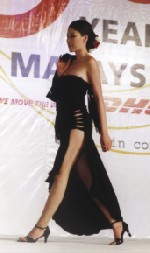 For
Tom Abang Saufi, a local Malaysian designer who has been working
in the fashion industry for eighteen years, bringing Malaysian
culture into the global market is equally important. Her collection
this year featured the signature ethnic motif of swirls -- a
symbol from the ethnic group, Orangulu, -- using sheer fabrics.
Because she is influenced and inspired by the art of wrapping
and tying (sari and sarong-style) she does not use fastenings
and zips. "I always design things that tie like sarongs,
because they are user-friendly," she says. "I love
doing an unorthodox mixing of colours. Fashion to me is a passion,
which evolves all the time. I think designers have gotten very
good feedback from Malaysians and as long as we keep up the
production and standards of our work, there is no reason we
should not be able to compete globally."
For
Tom Abang Saufi, a local Malaysian designer who has been working
in the fashion industry for eighteen years, bringing Malaysian
culture into the global market is equally important. Her collection
this year featured the signature ethnic motif of swirls -- a
symbol from the ethnic group, Orangulu, -- using sheer fabrics.
Because she is influenced and inspired by the art of wrapping
and tying (sari and sarong-style) she does not use fastenings
and zips. "I always design things that tie like sarongs,
because they are user-friendly," she says. "I love
doing an unorthodox mixing of colours. Fashion to me is a passion,
which evolves all the time. I think designers have gotten very
good feedback from Malaysians and as long as we keep up the
production and standards of our work, there is no reason we
should not be able to compete globally."
Apart
from bringing Malaysia to the global fashion sphere, KL Fashion
Week, also gave both local and international designers a chance
to interact with other fashion aficionados and designers, and
allowed them to open up new lines of communication with each
other.
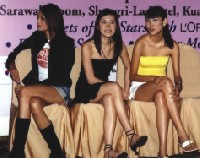 This
was Chinese designer Wu Haiyan's first time in Malaysia. Having
a "strong preference for silk," her collection this
year included silk gowns, sparkly tops, tutu skirts with ruffles,
sheer fabrics with inciting diagonal-shaped cuts on the backs
of her gowns and high slits on the side. Adding to the funk
factor was one particular outfit, in which the skirt was half
layered and half rope-like straps. Looking forward to opening
a new market in Malaysia, she hopes that MODA (Malaysian Official
Designers Association) will work together with the Chinese Fashion
Association to exchange information, marketing and other relevant
news.
This
was Chinese designer Wu Haiyan's first time in Malaysia. Having
a "strong preference for silk," her collection this
year included silk gowns, sparkly tops, tutu skirts with ruffles,
sheer fabrics with inciting diagonal-shaped cuts on the backs
of her gowns and high slits on the side. Adding to the funk
factor was one particular outfit, in which the skirt was half
layered and half rope-like straps. Looking forward to opening
a new market in Malaysia, she hopes that MODA (Malaysian Official
Designers Association) will work together with the Chinese Fashion
Association to exchange information, marketing and other relevant
news.
KL
Fashion Week carved out a mark for Asia's fashion industry in
the global scene. Supported by the Ministry of Tourism Malaysia,
Shopping Malaysia Secretariat and Kuala Lumpur City Hall, The
Star's official and media partners also included Malaysia Airlines,
Shangri-La Hotel, DHL, Fujifilm, TV3, Radio Era, China Press,
Nanyang Siang, Harpers Bazaar, The Malaysian Women's Weekly
and Monorail Multimedia.
 Originally
a regional newspaper when it came out in 1971, The Star now
has a circulation of 300,000 all over Malaysia. It became a
national newspaper in 1976 and was the first Malaysian newspaper
to start an internet edition in 1995. Supplements and other
publications of the Star are: Kuntum (an educational
monthly magazine for children in Bahasa Malaysia), Shang
Hai (a business magazine in Chinese) Galaxie (an
English magazine for young adults) and Flavours (a
magazine focusing on food and lifestyle).
Originally
a regional newspaper when it came out in 1971, The Star now
has a circulation of 300,000 all over Malaysia. It became a
national newspaper in 1976 and was the first Malaysian newspaper
to start an internet edition in 1995. Supplements and other
publications of the Star are: Kuntum (an educational
monthly magazine for children in Bahasa Malaysia), Shang
Hai (a business magazine in Chinese) Galaxie (an
English magazine for young adults) and Flavours (a
magazine focusing on food and lifestyle).
To
add to the pomp and circumstance of KL Fashion Week, famous
designer Jimmy Choo, based in London, but never forgetting his
home country, came to a few of the events. "This is a good
exposure for Malaysians," says Jimmy Choo. "It's good
for people to get an idea of what the new season is bringing
and for designers to work alongside other international fashion
figures. The most important thing to remember is to work hard
and be yourself. Remain what you are."
Asian
designers are learning that they do not have to compromise their
culture and traditions to compete internationally. Fashion,
at the end of the day, is all about expressing yourself and
where you come from. Anything less would just be passé.

 With
a global image of being an icon of the progressive east and
at the same time, as being one of Asia's most "hip and
trendy" metropolises, Kuala Lumpur is definitely the epitome
of a perfect blend between eastern and western traditions. While
staying true to their culture, the citizens of KL are also taking
globalisation into stride, which was evident during the nine-day-long
"KL Fashion Week," held from April 24 to May 2, consisting
of a number of different events, ranging from all day workshops
on beauty, to glamorous fashion shows. Organised by The Star
Newspaper in Malaysia and presented by L'Oreal, this is KL Fashion
Week's second consecutive year.
With
a global image of being an icon of the progressive east and
at the same time, as being one of Asia's most "hip and
trendy" metropolises, Kuala Lumpur is definitely the epitome
of a perfect blend between eastern and western traditions. While
staying true to their culture, the citizens of KL are also taking
globalisation into stride, which was evident during the nine-day-long
"KL Fashion Week," held from April 24 to May 2, consisting
of a number of different events, ranging from all day workshops
on beauty, to glamorous fashion shows. Organised by The Star
Newspaper in Malaysia and presented by L'Oreal, this is KL Fashion
Week's second consecutive year.  With
a guest list comprising of the glitterati of Malaysia including
Ms. Malaysia--2003, Elaine Daly and actor Shamser Sidhu, KL
Fashion Week offered its participants global fashion exposure
in a number of ways. In contrast to last year, which featured
mostly local designers and models, this year's Fashion Week
was more inclusive of international designers and models. Participating
countries were India, Pakistan, Indonesia, Singapore, China,
Hong Kong and the Philippines, with the intention of taking
Malaysia's fashion industry a step closer to the global market.
With
a guest list comprising of the glitterati of Malaysia including
Ms. Malaysia--2003, Elaine Daly and actor Shamser Sidhu, KL
Fashion Week offered its participants global fashion exposure
in a number of ways. In contrast to last year, which featured
mostly local designers and models, this year's Fashion Week
was more inclusive of international designers and models. Participating
countries were India, Pakistan, Indonesia, Singapore, China,
Hong Kong and the Philippines, with the intention of taking
Malaysia's fashion industry a step closer to the global market.
 The word on the
street is that the 80's look is out and the 70's resort (long
pant legs and sarongs) and 50's tourist (big skirts, jackets
without buttons, capris) looks are in. Think bold: the flag
motif (which gives a sporty flavour to the outfit), stripes
and graphics (for a more urban feel), flowers (for the feminine,
girly look) and madras prints (for the exotic look). Fabrics
range from chiffons (for an ethereal touch) and shiny glamorous
silks, to a more toned down and earthy rough look, which is
termed "plastic bandage" because of the way it feels.
To add that extra touch to your outfit, try ruffles, feathers
or glitter, but let go of the lace, because it's no longer in.
Experiment with contrasting and using bright colours. At the
end of the day, your image portrays who you are, so stay true
to yourself, above all else, which seemed to be every designer's
final say on fashion.
The word on the
street is that the 80's look is out and the 70's resort (long
pant legs and sarongs) and 50's tourist (big skirts, jackets
without buttons, capris) looks are in. Think bold: the flag
motif (which gives a sporty flavour to the outfit), stripes
and graphics (for a more urban feel), flowers (for the feminine,
girly look) and madras prints (for the exotic look). Fabrics
range from chiffons (for an ethereal touch) and shiny glamorous
silks, to a more toned down and earthy rough look, which is
termed "plastic bandage" because of the way it feels.
To add that extra touch to your outfit, try ruffles, feathers
or glitter, but let go of the lace, because it's no longer in.
Experiment with contrasting and using bright colours. At the
end of the day, your image portrays who you are, so stay true
to yourself, above all else, which seemed to be every designer's
final say on fashion. "Fashion
is an attitude," says Malaysian designer Sayfol, whose
collection this year focused on designs from the 1920's, emphasis
on black with splashes of colour. "No fashion designer
can change you or make you into something you are not, because
fashion comes from within, from inside. You cannot wear something
that is not you, because fashion expresses who and what you
are."
"Fashion
is an attitude," says Malaysian designer Sayfol, whose
collection this year focused on designs from the 1920's, emphasis
on black with splashes of colour. "No fashion designer
can change you or make you into something you are not, because
fashion comes from within, from inside. You cannot wear something
that is not you, because fashion expresses who and what you
are." Four
local designers this year worked within the Muslim modes of
dressing. Their motto is "given the right fabric, colour
and design, Muslim fashion can be trendy." Designers from
boutiques Melor's Apparel, Boutique Ratu and Sri Munawwarah
showcased their take on Contemporary Fashion for Muslim Women
on the last day of Fashion Week in the KLCC Concourse Centre.
The sight of hijaabi models clad in outfits similar
to chic salwar kameezes -- be they glitzy bridal wear
in chiffon with sequins, or casual, comfortable, but snug attire
in local cotton fabrics and textile prints -- was a refreshing,
yet dramatic change from the daring outfits they had worn in
previous fashion shows.
Four
local designers this year worked within the Muslim modes of
dressing. Their motto is "given the right fabric, colour
and design, Muslim fashion can be trendy." Designers from
boutiques Melor's Apparel, Boutique Ratu and Sri Munawwarah
showcased their take on Contemporary Fashion for Muslim Women
on the last day of Fashion Week in the KLCC Concourse Centre.
The sight of hijaabi models clad in outfits similar
to chic salwar kameezes -- be they glitzy bridal wear
in chiffon with sequins, or casual, comfortable, but snug attire
in local cotton fabrics and textile prints -- was a refreshing,
yet dramatic change from the daring outfits they had worn in
previous fashion shows.  "Islam
is part of our Malaysian culture, so it's important to incorporate
that into the fashion industry here," says designer Amanda
Loke, who has been in the fashion industry for over ten years.
Malaysian by birth but based in Hong Kong and London, Loke has
offices in Greece, Malaysia as well as boutiques of her line
Aman Darling in St. Tropez, France. She specialises in luxury
resort-wear and beach-wear. She believes that "simplicity
is the key. My designs are practical, as well as feminine, stylish
and cool." Since her clientele ranges from young women
in their twenties to middle-aged women in their forties and
fifties, she designs "for everyone."
"Islam
is part of our Malaysian culture, so it's important to incorporate
that into the fashion industry here," says designer Amanda
Loke, who has been in the fashion industry for over ten years.
Malaysian by birth but based in Hong Kong and London, Loke has
offices in Greece, Malaysia as well as boutiques of her line
Aman Darling in St. Tropez, France. She specialises in luxury
resort-wear and beach-wear. She believes that "simplicity
is the key. My designs are practical, as well as feminine, stylish
and cool." Since her clientele ranges from young women
in their twenties to middle-aged women in their forties and
fifties, she designs "for everyone." For
Tom Abang Saufi, a local Malaysian designer who has been working
in the fashion industry for eighteen years, bringing Malaysian
culture into the global market is equally important. Her collection
this year featured the signature ethnic motif of swirls -- a
symbol from the ethnic group, Orangulu, -- using sheer fabrics.
Because she is influenced and inspired by the art of wrapping
and tying (sari and sarong-style) she does not use fastenings
and zips. "I always design things that tie like sarongs,
because they are user-friendly," she says. "I love
doing an unorthodox mixing of colours. Fashion to me is a passion,
which evolves all the time. I think designers have gotten very
good feedback from Malaysians and as long as we keep up the
production and standards of our work, there is no reason we
should not be able to compete globally."
For
Tom Abang Saufi, a local Malaysian designer who has been working
in the fashion industry for eighteen years, bringing Malaysian
culture into the global market is equally important. Her collection
this year featured the signature ethnic motif of swirls -- a
symbol from the ethnic group, Orangulu, -- using sheer fabrics.
Because she is influenced and inspired by the art of wrapping
and tying (sari and sarong-style) she does not use fastenings
and zips. "I always design things that tie like sarongs,
because they are user-friendly," she says. "I love
doing an unorthodox mixing of colours. Fashion to me is a passion,
which evolves all the time. I think designers have gotten very
good feedback from Malaysians and as long as we keep up the
production and standards of our work, there is no reason we
should not be able to compete globally." This
was Chinese designer Wu Haiyan's first time in Malaysia. Having
a "strong preference for silk," her collection this
year included silk gowns, sparkly tops, tutu skirts with ruffles,
sheer fabrics with inciting diagonal-shaped cuts on the backs
of her gowns and high slits on the side. Adding to the funk
factor was one particular outfit, in which the skirt was half
layered and half rope-like straps. Looking forward to opening
a new market in Malaysia, she hopes that MODA (Malaysian Official
Designers Association) will work together with the Chinese Fashion
Association to exchange information, marketing and other relevant
news.
This
was Chinese designer Wu Haiyan's first time in Malaysia. Having
a "strong preference for silk," her collection this
year included silk gowns, sparkly tops, tutu skirts with ruffles,
sheer fabrics with inciting diagonal-shaped cuts on the backs
of her gowns and high slits on the side. Adding to the funk
factor was one particular outfit, in which the skirt was half
layered and half rope-like straps. Looking forward to opening
a new market in Malaysia, she hopes that MODA (Malaysian Official
Designers Association) will work together with the Chinese Fashion
Association to exchange information, marketing and other relevant
news. Originally
a regional newspaper when it came out in 1971, The Star now
has a circulation of 300,000 all over Malaysia. It became a
national newspaper in 1976 and was the first Malaysian newspaper
to start an internet edition in 1995. Supplements and other
publications of the Star are: Kuntum (an educational
monthly magazine for children in Bahasa Malaysia), Shang
Hai (a business magazine in Chinese) Galaxie (an
English magazine for young adults) and Flavours (a
magazine focusing on food and lifestyle).
Originally
a regional newspaper when it came out in 1971, The Star now
has a circulation of 300,000 all over Malaysia. It became a
national newspaper in 1976 and was the first Malaysian newspaper
to start an internet edition in 1995. Supplements and other
publications of the Star are: Kuntum (an educational
monthly magazine for children in Bahasa Malaysia), Shang
Hai (a business magazine in Chinese) Galaxie (an
English magazine for young adults) and Flavours (a
magazine focusing on food and lifestyle).